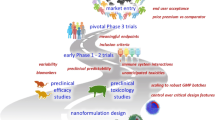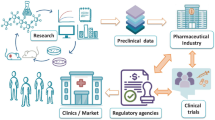Abstract
The vast majority of drug product candidates in early development fail to progress to clinics. This is true for products containing nanomaterials just as for other types of pharmaceuticals. Early development pathways should therefore place high priority on experiments that help candidates fail faster and less expensively. Nanomedicines fail for many reasons, but some are more avoidable than others. Some of the points of failure are not considerations in the development of small molecules or biopharmaceuticals, and so may be unexpected, even to those with previous experience bringing drug products to the clinic. This article reviews experiments that have proven useful in providing “go/no-go” decision-making data for nanomedicines in early preclinical development. Of course, the specifics depend on the particulars of the drug product and the nanomaterial type, and not every product shares the same development pathway or the same potential points of failure. Here, we focus on challenges that differ from those in the development of traditional small molecule therapeutics, and on experiments that reveal deficiencies that can only be corrected by essentially starting over—altering the nanomedicine to an extent that all previous characterization and proof-of-concept testing must be repeated. Conducting these experiments early in the development process can save significant resources and time and allow developers to focus on derisked candidates with a greater likelihood of ultimate success.





Similar content being viewed by others
References
Min Y, Caster JM, Eblan MJ, Wang AZ. Clinical translation of nanomedicine. Chem Rev. 2015;115(19):11147–90.
Noorlander CW, Kooi MW, Oomen AG, Park MV, Vandebriel RJ, Geertsma RE. Horizon scan of nanomedicinal products. Nanomedicine (Lond). 2015;10(10):1599–608.
Luo D, Carter KA, Lovell JF. Nanomedical engineering: shaping future nanomedicines. Wiley Interdiscip Rev Nanomed Nanobiotechnol. 2015;7(2):169–88.
Tyner KM, Zou P, Yang X, Zhang H, Cruz CN, Lee SL. Product quality for nanomaterials: current U.S. experience and perspective. Wiley Interdiscip Rev Nanomed Nanobiotechnol. 2015;7(5):640–54.
Bae YH, Park K. Targeted drug delivery to tumors: myths, reality and possibility. J Control Release. 2011;153(3):198–205.
Stern ST, Hall JB, Yu LL, Wood LJ, Paciotti GF, Tamarkin L, et al. Translational considerations for cancer nanomedicine. J Controlled Release. 2010;146(2):164–74.
Crist RM, Grossman JH, Patri AK, Stern ST, Dobrovolskaia MA, Adiseshaiah PP, et al. Common pitfalls in nanotechnology: lessons learned from NCI’s Nanotechnology Characterization Laboratory. Integr Biol (Camb). 2013;5(1):66–73.
Dicko A, Kwak S, Frazier AA, Mayer LD, Liboiron BD. Biophysical characterization of a liposomal formulation of cytarabine and daunorubicin. Int J Pharm. 2010;391(1–2):248–59.
Wei X, Cohen R, Barenholz Y. Insights into composition/structure/function relationships of Doxil gained from “high-sensitivity” differential scanning calorimetry. Eur J Pharm Biopharm. 2016.
Huang X, Peng X, Wang Y, Wang Y, Shin DM, El-Sayed MA, et al. A reexamination of active and passive tumor targeting by using rod-shaped gold nanocrystals and covalently conjugated peptide ligands. ACS Nano. 2010;4(10):5887–96.
Kunjachan S, Pola R, Gremse F, Theek B, Ehling J, Moeckel D, et al. Passive versus active tumor targeting using RGD- and NGR-modified polymeric nanomedicines. Nano Lett. 2014;14(2):972–81.
Duncan R, Gaspar R. Nanomedicine(s) under the microscope. Mol Pharm. 2011;8(6):2101–41.
Sykes EA, Chen J, Zheng G, Chan WC. Investigating the impact of nanoparticle size on active and passive tumor targeting efficiency. ACS Nano. 2014;8(6):5696–706.
Klibanov AL, Maruyama K, Beckerleg AM, Torchilin VP, Huang L. Activity of amphipathic poly(ethylene glycol) 5000 to prolong the circulation time of liposomes depends on the liposome size and is unfavorable for immunoliposome binding to target. Biochim Biophys Acta. 1991;1062(2):142–8.
Mullen DG, Fang M, Desai A, Baker JR, Orr BG, Banaszak Holl MM. A quantitative assessment of nanoparticle-ligand distributions: implications for targeted drug and imaging delivery in dendrimer conjugates. ACS Nano. 2010;4(2):657–70.
Hrkach J, Von Hoff D, Mukkaram Ali M, Andrianova E, Auer J, Campbell T, et al. Preclinical development and clinical translation of a PSMA-targeted docetaxel nanoparticle with a differentiated pharmacological profile. Sci Transl Med. 2012;4(128):128ra39.
Jokerst JV, Lobovkina T, Zare RN, Gambhir SS. Nanoparticle PEGylation for imaging and therapy. Nanomedicine (Lond). 2011;6(4):715–28.
Smith MC, Crist RM, Clogston JD, McNeil SE. Quantitative analysis of PEG-functionalized colloidal gold nanoparticles using charged aerosol detection. Anal Bioanal Chem. 2015;407(13):3705–16.
Makan AC, Spallek MJ, du Toit M, Klein T, Pasch H. Advanced analysis of polymer emulsions: particle size and particle size distribution by field-flow fractionation and dynamic light scattering. J Chromatogr A. 2016;1442:94–106.
Perry JL, Reuter KG, Kai MP, Herlihy KP, Jones SW, Luft JC, et al. PEGylated PRINT nanoparticles: the impact of PEG density on protein binding, macrophage association, biodistribution, and pharmacokinetics. Nano Lett. 2012;12(10):5304–10.
Baer DR, Engelhard MH, Johnson GE, Laskin J, Lai J, Mueller K, et al. Surface characterization of nanomaterials and nanoparticles: important needs and challenging opportunities. J Vac Sci Technol A. 2013;31(5):50820.
Rabanel JM, Hildgen P, Banquy X. Assessment of PEG on polymeric particles surface, a key step in drug carrier translation. J Controlled Release. 2014;185:71–87.
Ilinskaya AN, Dobrovolskaia MA. Nanoparticles and the blood coagulation system. Part II: safety concerns. Nanomedicine (Lond). 2013;8(6):969–81.
(USP) USP. <729> Globule size distribution in lipid injectable emulsions. Physical tests. Rockville, MD 2013.
Joubert MK, Hokom M, Eakin C, Zhou L, Deshpande M, Baker MP, et al. Highly aggregated antibody therapeutics can enhance the in vitro innate and late-stage T-cell immune responses. J Biol Chem. 2012;287(30):25266–79.
den Engelsman J, Garidel P, Smulders R, Koll H, Smith B, Bassarab S, et al. Strategies for the assessment of protein aggregates in pharmaceutical biotech product development. Pharm Res. 2011;28(4):920–33.
Driscoll DF, Etzler F, Barber TA, Nehne J, Niemann W, Bistrian BR. Physicochemical assessments of parenteral lipid emulsions: light obscuration versus laser diffraction. Int J Pharm. 2001;219(1–2):21–37.
Kotarek J, Stuart C, De Paoli SH, Simak J, Lin TL, Gao Y, et al. Subvisible particle content, formulation, and dose of an erythropoietin peptide mimetic product are associated with severe adverse postmarketing events. J Pharm Sci. 2016;105(3):1023–7.
Weaver JL, Boyne M, Pang E, Chimalakonda K, Howard KE. Nonclinical evaluation of the potential for mast cell activation by an erythropoietin analog. Toxicol Appl Pharmacol. 2015;287(3):246–52.
Wolfram J, Suri K, Yang Y, Shen J, Celia C, Fresta M, et al. Shrinkage of pegylated and non-pegylated liposomes in serum. Colloids Surf B Biointerfaces. 2014;114:294–300.
Capomaccio R, Jimenez IO, Colpo P, Gilliland D, Ceccone G, Rossi F, et al. Determination of the structure and morphology of gold nanoparticle-HSA protein complexes. Nanoscale. 2015;7(42):17653–7.
Aramesh M, Shimoni O, Ostrikov K, Prawer S, Cervenka J. Surface charge effects in protein adsorption on nanodiamonds. Nanoscale. 2015;7(13):5726–36.
Cedervall T, Lynch I, Lindman S, Berggard T, Thulin E, Nilsson H, et al. Understanding the nanoparticle-protein corona using methods to quantify exchange rates and affinities of proteins for nanoparticles. Proc Natl Acad Sci U S A. 2007;104(7):2050–5.
Modi S, Anderson BD. Determination of drug release kinetics from nanoparticles: overcoming pitfalls of the dynamic dialysis method. Mol Pharm. 2013;10(8):3076–89.
Ambardekar VV, Stern ST. NBCD pharmacokinetics and drug release methods. In: Crommelin DJA, de Viegler JSB, editors. Non-biological complex drugs; the science and the regulatory landscape. Springer; 2015. p. 261–87.
Skoczen S, McNeil SE, Stern ST. Stable isotope method to measure drug release from nanomedicines. J Controlled Release. 2015;220(Pt A):169–74.
Levin AA. A review of the issues in the pharmacokinetics and toxicology of phosphorothioate antisense oligonucleotides. Biochim Biophys Acta. 1999;1489(1):69–84.
Tamilvanan S, Raja NL, Sa B, Basu SK. Clinical concerns of immunogenicity produced at cellular levels by biopharmaceuticals following their parenteral administration into human body. J Drug Target. 2010;18(7):489–98.
Weiszhar Z, Czucz J, Revesz C, Rosivall L, Szebeni J, Rozsnyay Z. Complement activation by polyethoxylated pharmaceutical surfactants: Cremophor-EL, Tween-80 and Tween-20. Eur J Pharm Sci. 2012;45(4):492–8.
Dobrovolskaia MA. Pre-clinical immunotoxicity studies of nanotechnology-formulated drugs: challenges, considerations and strategy. J Controlled Release. 2015;220(Pt B):571–83.
Dobrovolskaia MA, McNeil SE. Immunological properties of engineered nanomaterials. Nat Nano. 2007;2(8):469–78.
Dobrovolskaia MA, McNeil SE. Understanding the correlation between in vitro and in vivo immunotoxicity tests for nanomedicines. J Controlled Release. 2013;172(2):456–66.
Dobrovolskaia MA, Neun BW, Clogston JD, Ding H, Ljubimova J, McNeil SE. Ambiguities in applying traditional Limulus amebocyte lysate tests to quantify endotoxin in nanoparticle formulations. Nanomedicine (Lond). 2010;5(4):555–62.
Dobrovolskaia MA, Neun BW, Clogston JD, Grossman JH, McNeil SE. Choice of method for endotoxin detection depends on nanoformulation. Nanomedicine (Lond). 2014;9(12):1847–56.
International A. ASTM F756 - 13 standard practice for assessment of hemolytic properties of materials. West Conshohocken, PA2013
Adiseshaiah PP, Hall JB, McNeil SE. Nanomaterial standards for efficacy and toxicity assessment. Wiley Interdiscip Rev Nanomed Nanobiotechnol. 2010;2(1):99–112.
Szebeni J, Muggia F, Gabizon A, Barenholz Y. Activation of complement by therapeutic liposomes and other lipid excipient-based therapeutic products: prediction and prevention. Adv Drug Deliv Rev. 2011;63(12):1020–30.
Johnson JI, Decker S, Zaharevitz D, Rubinstein LV, Venditti JM, Schepartz S, et al. Relationships between drug activity in NCI preclinical in vitro and in vivo models and early clinical trials. Br J Cancer. 2001;84(10):1424–31.
Gould SE, Junttila MR, de Sauvage FJ. Translational value of mouse models in oncology drug development. Nat Med. 2015;21(5):431–9.
Snipstad S, Hak S, Baghirov H, Sulheim E, Morch Y, Lelu S, et al. Labeling nanoparticles: dye leakage and altered cellular uptake. Cytometry A. 2016.
Mamidi RN, Weng S, Stellar S, Wang C, Yu N, Huang T, et al. Pharmacokinetics, efficacy and toxicity of different pegylated liposomal doxorubicin formulations in preclinical models: is a conventional bioequivalence approach sufficient to ensure therapeutic equivalence of pegylated liposomal doxorubicin products? Cancer Chemother Pharmacol. 2010;66(6):1173–84.
Wei A, Mehtala JG, Patri AK. Challenges and opportunities in the advancement of nanomedicines. J Controlled Release. 2012;164(2):236–46.
Hansen M, Smith MC, Crist RM, Clogston JD, McNeil SE. Analyzing the influence of PEG molecular weight on the separation of PEGylated gold nanoparticles by asymmetric-flow field-flow fractionation. Anal Bioanal Chem. 2015;407(29):8661–72.
Hinterwirth H, Wiedmer SK, Moilanen M, Lehner A, Allmaier G, Waitz T, et al. Comparative method evaluation for size and size-distribution analysis of gold nanoparticles. J Sep Sci. 2013;36(17):2952–61.
Paul SM, Mytelka DS, Dunwiddie CT, Persinger CC, Munos BH, Lindborg SR, et al. How to improve R&D productivity: the pharmaceutical industry’s grand challenge. Nat Rev Drug Discov. 2010;9(3):203–14.
Acknowledgments
This project has been funded in whole or in part with Federal funds from the National Cancer Institute, National Institutes of Health, under Contract No. HHSN261200800001E. The content of this publication does not necessarily reflect the views or policies of the Department of Health and Human Services, nor does mention of trade names, commercial products, or organizations imply endorsement by the U.S. Government. The authors thank the scientists and staff of the Nanotechnology Characterization Lab (NCL), with special thanks to Scott McNeil, Stephan Stern, Marina Dobrovolskaia, and Magdalena Scully for helpful discussions and Allen Kane for assistance with figures.
Author information
Authors and Affiliations
Corresponding author
Additional information
Guest Editors: Katherine Tyner, Sau (Larry) Lee, and Marc Wolfgang
Rights and permissions
About this article
Cite this article
Grossman, J.H., Crist, R.M. & Clogston, J.D. Early Development Challenges for Drug Products Containing Nanomaterials. AAPS J 19, 92–102 (2017). https://doi.org/10.1208/s12248-016-9980-4
Received:
Accepted:
Published:
Issue Date:
DOI: https://doi.org/10.1208/s12248-016-9980-4




